The Real Story of the Holy Grail: Enchanted Chalices from Across the Globe
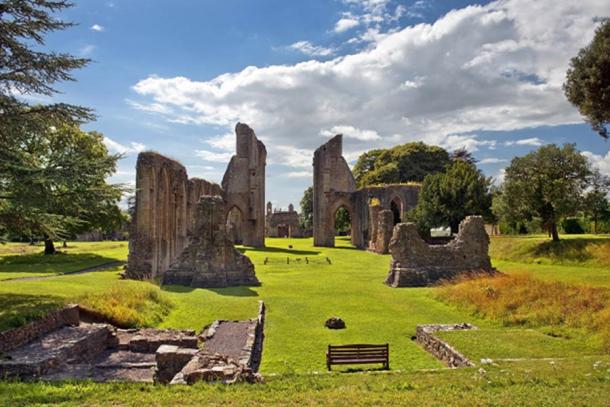
Most people identify one special chalice as the only Holy Grail. Others point out that the Holy Grail legends composed in Europe during the 12th to 15th centuries enumerate more than ten different Holy Grails. A third group contends that Holy Grails have existed around the globe for thousands of years. In truth, Holy Grails have been everywhere in every age. They have taken the form of chalices, spears, skulls, platters, stones, swords, cauldrons and even books. What makes an object a Holy Grail is its possession of a special power that has been called the Holy Spirit by Christians, the Alchemical Force by Alchemists, and Kundalini by Hindu Yogis. Legend has it that if you drink or eat from a Holy Grail, or even just touch it, its power will enter you and initiate a process of alchemical transformation that will subsequently heal you, enlighten you, and possibly even make you immortal.
The most famous historical Holy Grail is the Cup of Christ or Joseph of Arimathea’s Cup. This is the vessel that Joseph of Arimathea caught the blood and sweat of the Messiah in after he was taken down from the Cross, and it is also the chalice that Jesus passed among his disciples during the Last Supper. According to one legend, the Archangel Gabriel instructed Joseph and eleven other missionaries to travel with the cup and two flasks, or “cruets,” containing Jesus’s blood and sweat to Glastonbury. Once settled in their new homeland, Joseph and his companions constructed St. Mary’s Chapel, which became the chalice’s reliquary and the first Christian Church in Europe. The chapel was eventually torn down and replaced with a larger chapel that was subsequently incorporated into the structure of Glastonbury Abbey. Before Joseph died, it is said that he buried the Cup of Christ in a large mound of Glastonbury now known as Chalice Hill. Or, states another myth, Joseph secreted his Holy Grail in the Chalice Well, where today blood-colored water, symbolizing the blood of the Messiah, continually flows out to nourish and heal all bathe in it or drink it.

The ruins of Glastonbury Abbey in Somerset, England. (irisphoto1 /Adobe Stock)
According to an alternate legend regarding the Cup of Christ, after the Ascension Joseph’s chalice was taken by St. Peter to Rome, where it became the principal cup used by the early popes during the Holy Communion. Then, in approximately 258 CE, when the Roman Emperor Valerianus was regularly persecuting bishops and other high-ranking Catholic Church officials, a Vatican soldier took the chalice to Spain. It eventually made its way to the Cathedral of Valencia where it became famous as the Santo Caliz of Valencia. According to the Vatican, this is the true Cup of Christ. The Santo Caliz, meaning “Holy Chalice,” is a stone chalice made out of a type of red agate that sits upon an ornate base studded with 27 pearls, 2 rubies, and 2 emeralds. While the agate cup dates from the time of Christ, its decorative base was added much later.
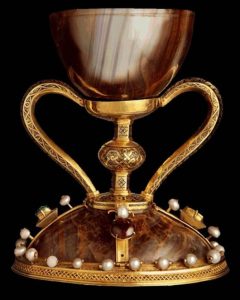
Only the cup at the top is said to be holy, the rest was added later. (JMJRIZ/CC BY-SA 4.0)
Although the Cup of Christ is indeed special, it is just one of many Holy Grails dating from the time of the Passion. Known collectively as the Arma Christi, these are the Articles of the Passion that became saturated with the spiritual power of Jesus while touching his body and/or holding his fluids. The Holy Grails of the Arma Christi include the True Cross that Jesus was nailed upon during the Crucifixion, the Crown of Thorns, the Veil of Veronica (the cloth that briefly covered his head), the Shroud of Turin (the cloth that covered Jesus’s corpse), and the Spear of Longinus. These Holy Grails have since been dispersed around the globe. The Spear of Longinus eventually found a home inside a Vatican pillar. The True Cross was divided up and its shards later interred within many cathedrals and churches in Europe and the US. The nails of the True Cross were removed and used to create both the Iron Crown of Lombardy that Napoleon crowned himself with, as well as the Spear of St. Maurice, aka the “Spear of Destiny.” This was the prized Holy Grail Spear of the Holy Roman Emperors, and later of Adolph Hitler.
Legend has it that the Knights Templar possessed all the Articles of the Passion at one time or another. Most of them were discovered by the warrior monks during the Fourth Crusade when they entered a small chapel in the Boukoleon Palace in Constantinople and discovered many Articles of the Passion along with the Head of John the Baptist. The Knights would later claim that John’s Head, which they called Baphomet, emanated the same spiritual power it did when it was on the body of the Baptist, thus making it a true Holy Grail. Since John had become known at that time by the inner circle of Templars as the “Savior and Maker of the Order,” his head immediately became the most cherished Holy Grail of the Knights.
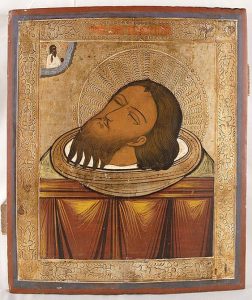
Illustration of the Head of Saint John the Baptist. (Public Domain)
Other Holy Grails Worldwide
Around the globe many Holy Grails have gained fame before and after the Passion. An earlier Holy Grail from the Holy Land, Solomon’s Chalice, was made from a huge emerald discovered in the Mediterranean Sea. The gem was brought to King Solomon, a world renowned alchemist, who then had it carved into an alchemical chalice. Although not much is known of Solomon’s Chalice, the famous Russian explorer and painter Nicholas Roerich claimed that he found legends of it in Russia’s Solovetz Monastery. After studying these legends, Roerich remarked: “Great is the Chalice of Solomon, fashioned from precious stone. On the Chalice are inscribed three verses in Sumerian characters and no one can explain them.”
Another ancient Holy Grail associated with Sumer is the Sumerian Grail. Arthur Edward Waite stated that he learned of this Grail vessel from one of his colleagues, Dr. Waddell, who apparently had a piece of it in his possession. Waddell stated that fragments of the Sumerian Grail had been discovered in the foundations of a tower belonging to “the oldest Sun Temple in Mesopotamia.” The vessel had anciently been hidden there by King Udu of Kish, the great-grandson of King Dur, the first Sumerian king and original owner of the chalice, who had apparently captured the cup from “aboriginal Chaldean Serpent-Worshippers” when he replaced dragon worship with a Sun-Cult. King Dur then engraved the vessel with “the oldest known historical inscription in the world,” which contained a genealogy of the ancient Sumerian kings.
Persia’s contribution to the list of Holy Grails includes the Jami-Jamshid, the Cup of Jamshid, which was discovered by the legendary Persian King Jamshid when he was excavating an ancient city in central Asia.
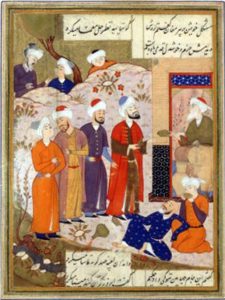
Ancient Persian poet Hafez looking at the Cup of Jamshid. Turkish manuscript of 1477, author unknown, from Shîrâz, Iran. (Public Domain)
Jamshid’s radiant chalice, which was made of pure turquoise, could both reveal the future and transform a human being into an immortal god. Another famous Persian Holy Grail resided at the court of King Key-Khosrow. Known as the Nartmongue, the “Knights’ Cup,” this chalice was passed among Persian knights at least a thousand years before Arthurian knights pursued their magical Holy Grail.
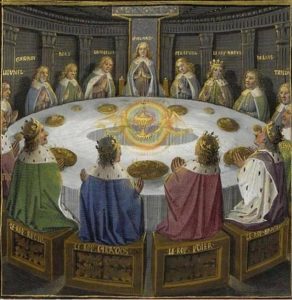
King Arthur’s knights, gathered at the Round Table, see a vision of the Holy Grail. (Public Domain)
In the Far East the existence of an ancient Holy Grail called the Chalice of Buddha was revealed to Nicholas Roerich when he traveled across China and Mongolia in the 1920s. Buddhist monks informed Roerich that the origin of the chalice was contained within a Jataka, an anecdotal story extracted directly from the life of Buddha, which stated:
“…from the four lands came the four guardians of the world… they offered four chalices made of black stone and [the Buddha], full of compassion for the four wise men, accepted the four chalices. He placed one inside the other and ordained, “Let there be one!” And the edges of the four became visible as outlines. All the Chalices formed one. The Buddha accepted food in the newly formed Chalice and, having partaken of food, he offered thanks.”
Roerich acquired additional information about the Chalice of Buddha when he passed through cities on the Silk Road. He writes:
“Karashahr is …the last resting place of the Chalice of Buddha, as cited by the historians. The Chalice of the Blessed One was brought here from Peshwar and disappeared here. It is said, “The Chalice of Buddha will be found again when the time of Shambhala [the Golden Age] approaches.”
A better known than the Chalice of Buddha is China’s Royal Cauldron, which is a large golden pot known to have once brought long life and prosperity to some of the early Chinese emperors. The Royal Cauldron was renowned for its alchemical properties and for magically manifesting within itself the elixir of immortality for righteous emperors, including the Emperor Hung-ti and the beneficent Emperor Wu of the Han Dynasty. But the Golden Cauldron would only assist righteous emperors.
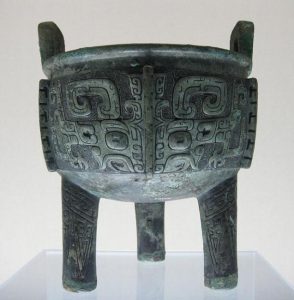
A tripod cauldron or ding from the late Shang Dynasty, China. (CC BY-SA 3.0)
Otherwise, as in the case of the evil Emperor Shi Huang-ti of the Chin Dynasty, the Royal Cauldron would mysteriously disappear and remain hidden until a more well-disposed ruler ascended the throne of China.